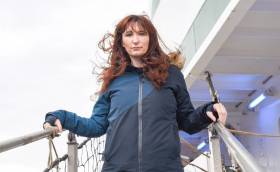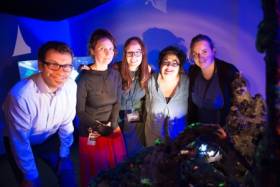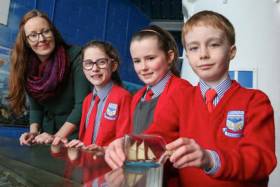Displaying items by tag: Louise Manifold
#MarineScience - As many as 12 artists, writers and musicians from Ireland and Europe have the opportunity to join expeditions on the research vessel RV Celtic Explorer and to work with marine scientists as part of an interdisciplinary art project for radio broadcast.
The three-year AerialSparks project will explore the potential of radio communication as a means to rethink our ocean wilderness as one of the last remaining unknowns.
AerialSparks has been created by artist Louise Manifold for Galway’s European Capital of Culture programme in 2020. Inspired by the concept of traditional broadcasting and the use of sonar and other technology for data collection, the project will result in a series of art works for radio.
Manifold, who previously worked with Galway schoolchildren on marine science and art projects, has commissioned artists from Ireland and Europe to develop new work based on their experiences of spending time at sea on research surveys carried out by the Marine Institute's research vessel, RV Celtic Explorer.
The Galway-born conceptual artist, currently on residency in Berlin, is keen to tap into the connections between radio as a communication and navigation tool, and discover how radio can make spaces visible to audiences.
“While at sea on the Explorer last year, I was extremely mindful of how radio can be listened to in solitude, yet bring people together providing a sense of togetherness,” she said. “It is amazing to think how early radio technology must have felt for many people bridging the distance of the ocean and bringing people together. Recognising the importance of technology, it continues to play a big part in how we understand the influences of the ocean.”
Taking part in the project are renowned artists David Stalling, Kennedy Brown, Carol Anne Connelly and Ailís Ní Riain, who will each spend up to two weeks at sea on the RV Celtic Explorer during scientific expeditions.
One of the surveys, overseen by Prof Andy Wheeler from UCC, includes monitoring deep-water coldwater corals reefs off the continental shelf, exploring the processes involved in understanding the coral habitats and sensitivity to climate change and human impacts.
The artists will have the opportunity to record data where advanced robotic technology and 3D visualisation tools will be used on the ROV Holland I at depths of 3,000m under the water.
Ireland’s offshore territory is 10 times the size of our land area, and marine research projects involving new technology help us learn more about the land under the sea, its geology and processes and how this impacts our lives.
Artists will also get to work with Prof Sergei Lebedev from the Dublin Institute for Advanced Studies (Dias), where research is being conducted looking at offshore earthquakes in the deepest parts of Ireland’s ocean.
With scientific equipment being deployed for the first time from the RV Celtic Explorer, including 18 ocean-bottom seismometers and an array of acoustic sensors, the survey will explore marine activity that can trigger undersea landslides.
Hannah Kiely, chief executive of Galway 2020, said of the project: “We are very excited about the waves of possibilities that the collaboration between arts and science presents particularly given the project’s focus on histories of the ocean voyage, maritime radio communication and how this might be felt and understood in a digital age. With our aim to be the first truly Virtual European Capital of Culture, digital is at the heart of our programme for Galway 2020.”
The ocean covers over 70 percent of the planet’s surface and with the advancement of marine technology, new discoveries are being made every day.
Marine Institute chief executive Dr Peter Heffernan added: “Aerial Sparks is an innovative opportunity for artists and marine scientists to learn new ways to connect and engage with the wider community.
“We are learning more about the ocean including new habitats being explored for the first time, new species being discovered, as well as the effects of climate change and understanding the impacts humans are having on the ocean.
“Therefore, increasing our awareness and narrative about the ocean is extremely important. Using the concept of sound and the sea is a unique way of showing how both the arts and sciences highlight the importance of exploration and curiosity.”
The Marine Institute is also hosting a series of lunchtime talks at its Galway headquarters for scientists, giving them the opportunity to meet artists working on the project, and to be introduced to their ideas, processes and future work for AerialSparks. For further information contact the research operations office at the Marine Institute.
AerialSparks is funded by the Arts Council of Ireland Project Awards, Galway 2020 and the Marine Institute.
Primary School Marine Science Art Project Shortlisted For Top Award
#MarineScience - Build Your Own Unknown, a marine science and art project by fourth-class pupils at Cregmore National School in Co Galway, has been shortlisted for the Allianz Business to Arts Awards.
As previously reported on Afloat.ie, the Cregmore pupils worked with artist Louise Manifold to produce their installation and short film, using images and footage from the ROV Holland I for inspiration in recreating the discovery of the Moytirra deep-sea hydrothermal vents in 2011.
The project — which places art, marine science and technology in the heart of the classroom — also involved TULCA in partnership with the Marine Institute’s Explorers Education Programme and marine scientist Dr Andy Wheeler from UCC.
Marine Institute chief executive Dr Peter Heffernan congratulated the team on their achievement and wished them luck for awards night.
“One of the greatest outcomes of the Build Your Own Unknown project was being able to provide an opportunity for artists, marine scientists and educators to work together to help engage and increase children, teachers and the wider community’s awareness about the importance of our ocean,” said Dr Heffernan.
The Allianz Business to Arts Awards recognise and champion the spirit of collaboration between businesses, artists and arts organisations that develop creative partnerships; bringing the arts and artists into mutually beneficial relationships across society.
The winners of this year’s Allianz Business to Arts Awards will be announced later this evening (Monday 4 September).
#MarineScience - Fourth-class pupils from Cregmore National School in Co Galway are creating a marine science and art installation and short film with artist Louise Manifold that re-enacts the 2011 discovery of the Moytirra deep-sea hydrothermal vents.
Build Your Own Unknown sees the school children use images and footage from the ROV Holland I for inspiration to recreate the discovery of the gigantic rock formations, ‘smoking’ lava vents over 10m high, and areas teeming with unusual species new to science at the Moytirra vent field in the Mid-Atlantic Ridge, some 3km below the surface north of the Azores.
Louise Manifold, the local artist leading the project, said: "As an artist I have always been fascinated by relationship between science and cinema, where often our connections to ocean is formed through our childhood imagination, from sci-fi films to childhood games and mythical stories.
“Build Your Own Unknown is not only about understanding our connections to the ocean, but it is about valuing human curiosity, and I am really enjoying the opportunity to work with the pupils of Cregmore to make an amazing piece of work that celebrates this."
Supported through the Marine Institute's Explorers Education Programme and the Tulca OFFshore programme, the marine science/art collaboration is welcomed by Marine Institute chief executive Dr Peter Heffernan.
"This is an innovative opportunity for artists, marine scientists and educators to engage and increase our awareness about the value, opportunities and societal benefits that the ocean provides us,” he said.
"Rediscovering the mystery of the ocean through the eyes of a scientist, the children have been given the opportunity to work with the Institute and Dr Andy Wheeler from UCC, who was the chief scientist on the research vessel RV Celtic Explorer, that had explored and aptly named Moytirra vents after a mythological Irish battlefield meaning plain of pillars.”
Build Your Own Unknown will be on show at SeaFest 2017, Ireland’s national maritime festival from 30 June to 2 July, which will promote the importance of ocean exploration as well as engage the wider community through visual arts.
The project will also include the development of cross-curricular education lesson plans and resources that teachers will be able to use for their own art-science project module. These will be available later this year at www.explorers.ie.































































